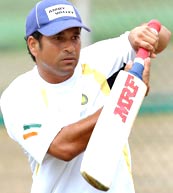Home > Cricket > Reuters > Report
Packed international cricket schedule taking its toll
Kunal Pradhan |
September 18, 2003 16:25 IST
Sachin Tendulkar was India's youngest Test player at the age of 16 in 1989 but it is highly unlikely he will finish his career as the oldest.
 The 30-year-old Tendulkar, widely regarded as the world's best batsman, has paid the price for the relentless schedule faced by international cricketers.
The 30-year-old Tendulkar, widely regarded as the world's best batsman, has paid the price for the relentless schedule faced by international cricketers.
He has suffered back, shoulder, toe, hamstring, ankle and hand injuries over the past four years, undergoing two operations.
Former England wicketkeeper Alec Stewart, who played 133 Tests before hanging up his boots this month at the age of 40, is an exception these days, with teams playing up to 15 Tests and 35 one-dayers a year.
That is roughly twice as many as 10 years ago, a surge of commercialisation and increased television coverage making armchair umpires of fans across the globe.
Next month, for example, Australia entertain Zimbabwe, India host New Zealand, South Africa will be in Pakistan and England travel to Bangladesh.
England then go to Sri Lanka, West Indies visit Zimbabwe and South Africa, and Australia host India, with the packed schedule having a direct impact on players' longevity.
Australia, by far the world's best team, have only four players who have survived regular top-flight international cricket for over five years.
Only Test captain Steve Waugh, 38, one-day skipper Ricky Ponting, experienced fast bowler Glenn McGrath, and leg spinner Shane Warne, though currently serving a drugs ban, have been virtually permanent fixtures in the side.
NO REPEAT
There could never be a repeat of the situation where Bobby Simpson returned 10 years after retiring as a 41-year-old to captain Australia as he did in 1977-78 when most of the regular players were sacked following the controversial World Series.
"I think burnout is the fear of everyone at the moment," Ponting said. "All players want to play as much as they can, but don't want to be worn out, fatigued and have their careers cut shorter."
The hectic calendar threatens fast bowlers, in particular.
 South African Allan Donald realised before most that he could not play every single match for his country, carefully selecting his appearances to extend his career through to this year's World Cup.
South African Allan Donald realised before most that he could not play every single match for his country, carefully selecting his appearances to extend his career through to this year's World Cup.
But Australian Jason Gillespie, England's Darren Gough and New Zealand's Chris Cairns, among others, have fought constant battles with injuries that have dogged their careers.
The main problem with overkill, however, is that even the sport's biggest fans have reached saturation point, an issue raised by Malcolm Gray, former president of the International Cricket Council.
"It is easy to play more cricket because the entertainment industry will throw money at you to play more and it is easy to be seduced by that money," he said.
India's one-day triangular tournament victory (joint winners with SA) in Dhaka in April went almost unnoticed just a few weeks after the World Cup ended.
It is also much more difficult now for players to get lucrative sponsorships than before the World Cup.
Advertisers realise there is only so much money to be made from the cricket pie, even in India where the sport is a religion among the one billion population.
The players, however, cannot afford to fret about cash as they must concentrate all their efforts on simply staying fit.